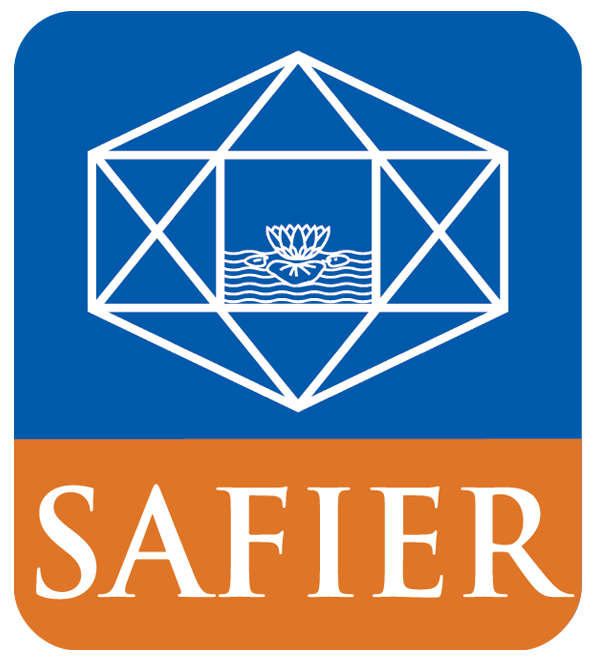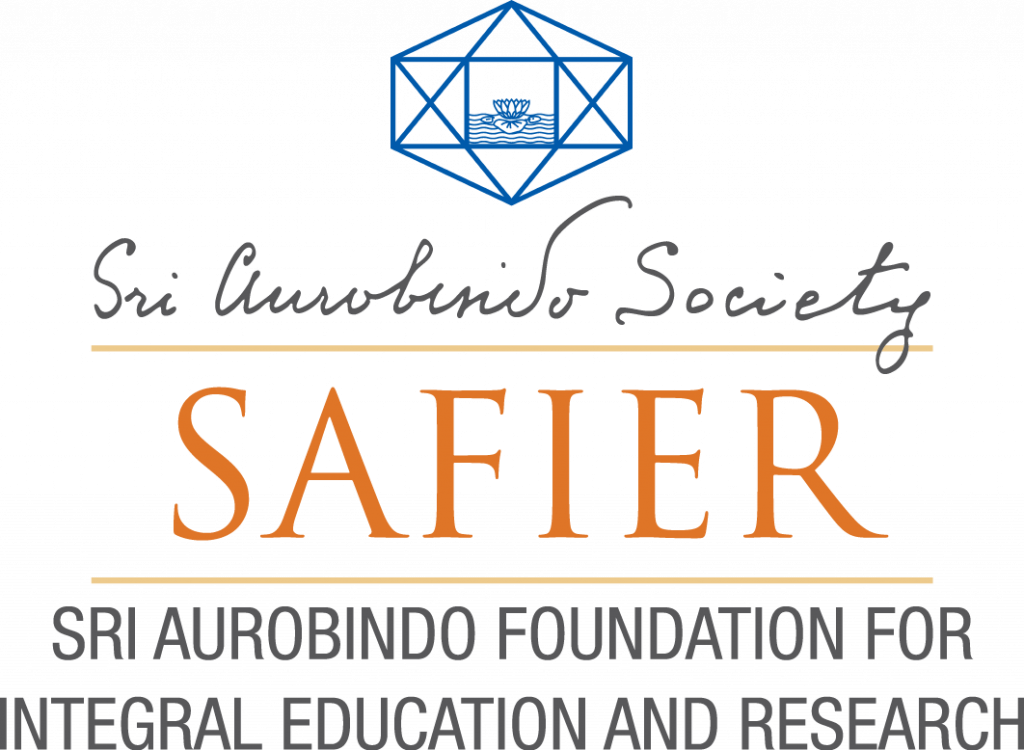Week 2
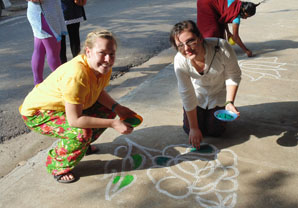 There were various presentations made and classes conducted by members and educators at SAS such as one by Dr Sampadananda Mishra to help the Oregonians explore Indian culture and Sanskrit and their significance to the world. Dr Mishra further elaborated on an ancient tradition of multiple concentrations to provide an appreciation of the tremendous potential and possibilities of the human mind. As part of providing a wider perspective and spectrum by educationists, Dr Alok Pandey gave an insight into the difference of eastern and western approaches to health. Under the guiding hands of Chandni ‘Di’, as she is fondly called, traditional, artistic and ethnic activities including Indian cooking, saree shopping, and creating the beautiful kolam art were experienced and enjoyed. This delightful palette of events included a demonstration of the world’s oldest martial art, known as Kalaripayattu, which is daily practiced in the nearby town of Auroville.
There were various presentations made and classes conducted by members and educators at SAS such as one by Dr Sampadananda Mishra to help the Oregonians explore Indian culture and Sanskrit and their significance to the world. Dr Mishra further elaborated on an ancient tradition of multiple concentrations to provide an appreciation of the tremendous potential and possibilities of the human mind. As part of providing a wider perspective and spectrum by educationists, Dr Alok Pandey gave an insight into the difference of eastern and western approaches to health. Under the guiding hands of Chandni ‘Di’, as she is fondly called, traditional, artistic and ethnic activities including Indian cooking, saree shopping, and creating the beautiful kolam art were experienced and enjoyed. This delightful palette of events included a demonstration of the world’s oldest martial art, known as Kalaripayattu, which is daily practiced in the nearby town of Auroville.
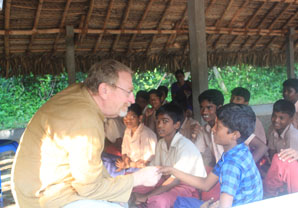 Adding to the enrichment of the experiences, the students found themselves working with the leaders of conscious farming in Matrikunj, learning about growing organic vegetables and medicinal plants in an atmosphere rich with positive vibrations; visiting a nearby ancient town which is famous for 1,600-year-old monolithic, shoreline Shiva temples with hand-carved sculptures; and practicing making kolams (a south Indian art form of decorating courtyards and prayer rooms floors with vibrant colours and geometrical designs) with the local women, in an effort to carry back a few strokes of Indian art and beauty with them. There was many brief discussions on Indian spirituality with one of the Society coordinators, Shivakumar, who during one session included a conversation about the significance, role and function of the Indian trinity—Brahma, Vishnu, and Shiva. A couple of trips to Matrikunj added to the appreciation of nature in its bounty, where various methods of organic farming and farming of medicinal plants were discussed. The group went around observing how conscious farming was successfully being conducted at ‘Mother’s Garden’ by Baburam-ji, the learned cultivator and herbalist, and his team. The group also went for a boat ride on beautiful Ousteri Lake nearby.
Adding to the enrichment of the experiences, the students found themselves working with the leaders of conscious farming in Matrikunj, learning about growing organic vegetables and medicinal plants in an atmosphere rich with positive vibrations; visiting a nearby ancient town which is famous for 1,600-year-old monolithic, shoreline Shiva temples with hand-carved sculptures; and practicing making kolams (a south Indian art form of decorating courtyards and prayer rooms floors with vibrant colours and geometrical designs) with the local women, in an effort to carry back a few strokes of Indian art and beauty with them. There was many brief discussions on Indian spirituality with one of the Society coordinators, Shivakumar, who during one session included a conversation about the significance, role and function of the Indian trinity—Brahma, Vishnu, and Shiva. A couple of trips to Matrikunj added to the appreciation of nature in its bounty, where various methods of organic farming and farming of medicinal plants were discussed. The group went around observing how conscious farming was successfully being conducted at ‘Mother’s Garden’ by Baburam-ji, the learned cultivator and herbalist, and his team. The group also went for a boat ride on beautiful Ousteri Lake nearby.
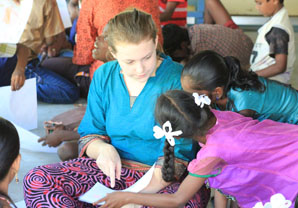 Sushanto-Da, a renowned painter, art researcher and teacher, and Professor Subhramani involved the group in a discussion on the esoteric symbolism of the south Indian temple architecture which is directly relative to the ancient culture and traditions that Indians have followed till the current century. This was in context with a trip to the ancient town of Mahabalipuram and also in reference to SHARANAM, one of the top five green buildings of India (as awarded by United Nations Environment Programme [UNEP]). Set in rural Tamil Nadu on the outskirts of Pondicherry, the architects of SHARANAM have left no stone unturned to make it as environment-friendly and self-sustainable as possible, adopting measures such as resource management, water conservation, and renewable energy, while providing for the people of the adopted villages by SARVAM a backdrop of space which is suited to the ideals of their educational, economic and social programmes. The process of its making is that of taking great strides on socio-economic as well as the developmental fronts. The project was led by hands-on architects who worked day in and day out to train and upgrade local unskilled workers from surrounding villages. Often in the grips of alcoholism, illiteracy, and poverty, the common labourers were not only building a communal space but they were transforming their own lives. The UO students were awed to see such a monumental feat in action. With this experience, they took away inspiration and hope of the possibilities that arise with a focused mind, divine faith and determined hands.
Sushanto-Da, a renowned painter, art researcher and teacher, and Professor Subhramani involved the group in a discussion on the esoteric symbolism of the south Indian temple architecture which is directly relative to the ancient culture and traditions that Indians have followed till the current century. This was in context with a trip to the ancient town of Mahabalipuram and also in reference to SHARANAM, one of the top five green buildings of India (as awarded by United Nations Environment Programme [UNEP]). Set in rural Tamil Nadu on the outskirts of Pondicherry, the architects of SHARANAM have left no stone unturned to make it as environment-friendly and self-sustainable as possible, adopting measures such as resource management, water conservation, and renewable energy, while providing for the people of the adopted villages by SARVAM a backdrop of space which is suited to the ideals of their educational, economic and social programmes. The process of its making is that of taking great strides on socio-economic as well as the developmental fronts. The project was led by hands-on architects who worked day in and day out to train and upgrade local unskilled workers from surrounding villages. Often in the grips of alcoholism, illiteracy, and poverty, the common labourers were not only building a communal space but they were transforming their own lives. The UO students were awed to see such a monumental feat in action. With this experience, they took away inspiration and hope of the possibilities that arise with a focused mind, divine faith and determined hands.
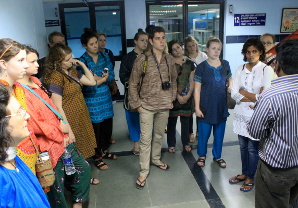 A visit to the Crocodile Farm and the serpentarium run by the Irulas tribesman also made the visitors aware of the daily struggles and dangers a rural populace faces in everyday, coexisting with dangerous crocodiles and poisonous snakes. The Irulas are an indigenous group from the jungles of southern India and legendary snake-catchers, who have an unlimited amount of experience and training in their bloodline that allows them to be some of the most efficient snake charmers in the world. In a conservation effort, the Irulas played a central role in capturing, milking the snakes for venom, and then releasing them in their natural habitat. The venom is then processed and used for significant cancer and antivenin research. The students were left with a better awareness of the day-to-day struggles Indian villagers face just to etch out a living and what the conservation effort has done to recuperate the dwindling numbers of local species of reptiles and other creatures.
A visit to the Crocodile Farm and the serpentarium run by the Irulas tribesman also made the visitors aware of the daily struggles and dangers a rural populace faces in everyday, coexisting with dangerous crocodiles and poisonous snakes. The Irulas are an indigenous group from the jungles of southern India and legendary snake-catchers, who have an unlimited amount of experience and training in their bloodline that allows them to be some of the most efficient snake charmers in the world. In a conservation effort, the Irulas played a central role in capturing, milking the snakes for venom, and then releasing them in their natural habitat. The venom is then processed and used for significant cancer and antivenin research. The students were left with a better awareness of the day-to-day struggles Indian villagers face just to etch out a living and what the conservation effort has done to recuperate the dwindling numbers of local species of reptiles and other creatures.
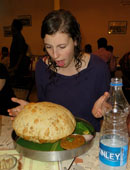 Till a few decades back, India was experiencing an immense problem of preventable blindness, which affected the livelihood of millions. To combat such a dire situation, Dr G. Venkataswamy, inspired by Sri Aurobindo’s and the Mother’s teachings, established a private hospital with world-class facilities for the poorest of the poor and named it the Aravind Eye Hospital (AEH), focusing on eradicating blindness and treating common eye problems to prevent loss in vision. His relentless research and dedication led to an assembly-line model of eye treatments, often known as the McDonald’s of eye care, which has taken diagnoses, surgeries and management of blindness in large quantities at extremely affordable costs. Since its inception, AEH has grown into a network of 8 eye hospitals that have treated a total of nearly 32 million patients in 36 years and performed nearly 4 million eye surgeries, majority of them being very cheap or free. The model of Aravind Eye Care hospitals has been applauded all over the world and has become a subject for numerous case studies. The UO students were visibly moved to study the history of such an initiative and witness the processes on the floors of the hospital, methods and apparatuses of surgical treatments developed indigenously, and innovative inside-out treatments to formulate growth and welfare of the local population. The tour of the facilities and then programmes offered an insight into the role of women, frequently high school graduates from the surrounding villages, who are trained to take up the outreach and healthcare work of the hospital. Dr Venkataswamy’s dream project provided a unique example of social responsibility and an invaluable lesson the students would like to carry with themselves replicate in various ways in their own lives.
Till a few decades back, India was experiencing an immense problem of preventable blindness, which affected the livelihood of millions. To combat such a dire situation, Dr G. Venkataswamy, inspired by Sri Aurobindo’s and the Mother’s teachings, established a private hospital with world-class facilities for the poorest of the poor and named it the Aravind Eye Hospital (AEH), focusing on eradicating blindness and treating common eye problems to prevent loss in vision. His relentless research and dedication led to an assembly-line model of eye treatments, often known as the McDonald’s of eye care, which has taken diagnoses, surgeries and management of blindness in large quantities at extremely affordable costs. Since its inception, AEH has grown into a network of 8 eye hospitals that have treated a total of nearly 32 million patients in 36 years and performed nearly 4 million eye surgeries, majority of them being very cheap or free. The model of Aravind Eye Care hospitals has been applauded all over the world and has become a subject for numerous case studies. The UO students were visibly moved to study the history of such an initiative and witness the processes on the floors of the hospital, methods and apparatuses of surgical treatments developed indigenously, and innovative inside-out treatments to formulate growth and welfare of the local population. The tour of the facilities and then programmes offered an insight into the role of women, frequently high school graduates from the surrounding villages, who are trained to take up the outreach and healthcare work of the hospital. Dr Venkataswamy’s dream project provided a unique example of social responsibility and an invaluable lesson the students would like to carry with themselves replicate in various ways in their own lives.
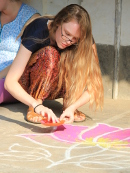 During the last session, the students were given time to reflect over their packed exploration. Vijaybhai, a father figure and member executive at Sri Aurobindo Society chatted with the group about what they thought was the true meaning of service. To this, some replied in terms of ‘joy in giving’, ‘empathy’, ‘personal growth’, and even ‘giving without the expectation of receiving’. Pleased at their insight, Vijaybhai added the virtue of developing inner strength, from which all other virtues are made possible to giving. The explorative study was beautifully summarized by Vijaybhai from a quote that captures the essence of their visit and the students’ aspirations of the future. ‘You cannot gift a flower without getting the fragrance on your hands.’
During the last session, the students were given time to reflect over their packed exploration. Vijaybhai, a father figure and member executive at Sri Aurobindo Society chatted with the group about what they thought was the true meaning of service. To this, some replied in terms of ‘joy in giving’, ‘empathy’, ‘personal growth’, and even ‘giving without the expectation of receiving’. Pleased at their insight, Vijaybhai added the virtue of developing inner strength, from which all other virtues are made possible to giving. The explorative study was beautifully summarized by Vijaybhai from a quote that captures the essence of their visit and the students’ aspirations of the future. ‘You cannot gift a flower without getting the fragrance on your hands.’
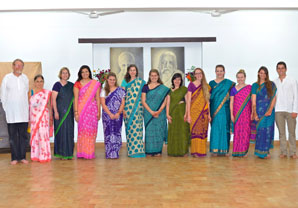 The overall programme far exceeded the expectations of the UO students and those of Dr Subramani. The University of Oregon students were often heard making comments such as ‘this visit has changed my life and perspective’. Their newly found appreciation of a world so different to their own and their enhanced learning were such eye-openers that all the students have indicated that they would like to return to spend more time on many of the projects run by the Society. Many have already begun to get involved in long-term projects and see themselves as being part of a continuing sustainable relationship between the SAS and UO, and working toward a meaningful collaboration between India and the United States.
The overall programme far exceeded the expectations of the UO students and those of Dr Subramani. The University of Oregon students were often heard making comments such as ‘this visit has changed my life and perspective’. Their newly found appreciation of a world so different to their own and their enhanced learning were such eye-openers that all the students have indicated that they would like to return to spend more time on many of the projects run by the Society. Many have already begun to get involved in long-term projects and see themselves as being part of a continuing sustainable relationship between the SAS and UO, and working toward a meaningful collaboration between India and the United States.
It has also been a fulfilling experience for all the resource persons of Sri Aurobindo Society who were involved in the programme. There was a sense of deep satisfaction at the fundamental exchanges that united the geographical East and West and also a mutual feeling of respect and appreciation for the other. The need for many such programmes was also felt by all to enrich each other’s perspectives, learning and lives.
